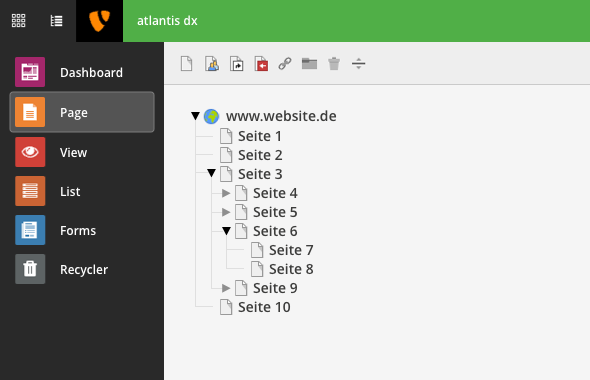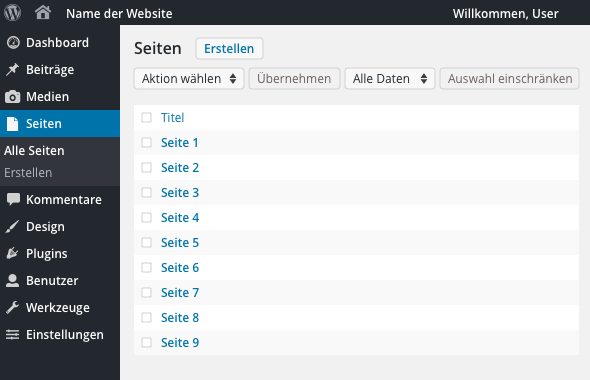Are you looking for a content management system for your web project? In this article, we take a closer look at the two CMSs in comparison and reveal the most important differences.
What is a CMS?
The abbreviation CMS stands for content management system. The composition of the term already reveals what lies behind this term: a system that manages digital content - for example, that of a website.
A website usually consists of several subpages with text, images and multimedia elements. Nowadays, the content on websites is rarely rigid. Dynamic content is in demand because it provides website visitors with added value and at the same time has a positive effect on search engine rankings. As an entrepreneur, you need a CMS so that you can maintain your website yourself without any programming or design knowledge. Ready-made or individually designed templates define the layout of the website so that you only have to take care of the content after setting up your content management system.
They are characterized by the fact that they are user-friendly and you can operate the software largely without any prior technical knowledge. In this way, various employees of your company can work on the editorial content of a website at the same time. You do not need external service providers to maintain your website, saving you time and money. You should only rely on IT specialists for the initial setup of the CMS and for service requests, for example for technical problems, updates or maintenance work.
WordPress and TYPO3: The most important differences
WordPress is the world's most widely used CMS solution with a market share of 64.1% (source: Statista, as of 2022). The open source software was originally developed for blogs and gained popularity through bloggers and hobby websites. Today, many medium-sized companies also rely on the free CMS. Thanks to numerous functions and extensions, it is also suitable for more complex websites.
TYPO3 was developed in 2001 for the administration of professional company websites. To this day, this solution, which is also freely accessible, is particularly popular with medium-sized companies. TYPO3 provides perfect conditions for large web projects with a large number of subpages as well as for individual requirements in terms of layout and design.
Is the question of which CMS is better already answered with WordPress' larger market share? No, it's not that simple. Both solutions have strengths and weaknesses. You can find out what these are in the following section.
Setting up the CMS
WordPress clearly has the edge when it comes to installation. The free CMS can be set up in just a few minutes without any prior knowledge. With some hosters, you can carry out the installation with one click and then immediately log into the WordPress backend to start building your website.
Setting up TYPO3 is more complicated. You need technical know-how here. That's why it's best to have your TYPO3 CMS set up by a professional service provider. A specialist will set up the system for you in just a few minutes and adjust it optimally to your individual needs.
Themes and responsive web design
The layout of a website should be contemporary, user-friendly and functional. WordPress provides a variety of ready-made designs, the so-called themes. Most of them are already responsive, i.e. optimized for different screen sizes and meet the requirements of modern web design. All you have to do is choose from one of the numerous templates. The finished themes can be customized to a greater or lesser extent. Colour and font adjustments are standard, but the templates quickly reach their limits when it comes to further optimizations. Free themes in particular often only offer limited functions.
TYPO3 also comes with some ready-made design templates. However, the selection is not as large as with WordPress. TYPO3 is designed for individual solutions and is therefore ideal if you want a unique design and want to hire a design agency, for example. This way, you end up with a website that is perfectly tailored to your needs.
Extensions
Both WordPress and TYPO3 offer a wide range of extensions with which you can expand the functions of your website and customize your theme. At first glance, WordPress offers a significantly larger number of extensions, but TYPO3 already provides many useful functions in the standard version. This has one advantage: the website performs better and runs more stably. On the other hand, installing different plugins with WordPress often leads to technical errors, as the extensions interfere with each other. Troubleshooting is then extremely time-consuming, especially for inexperienced WordPress users.
Have you created a blog with TYPO3 and would like to know which extensions are worthwhile? Read our article on the topic of TYPO3 blogs: The top 9 extensions.
User-friendliness and operation
Both content management systems score with a user-friendly interface. With WordPress, even CMS newcomers can easily manage the content of their website. The user interface is clearly laid out and can be operated intuitively. This is ensured by a visual editor with which the individual contents can be put together simply by drag-and-drop or with a few mouse clicks.
But even with TYPO3, you can easily edit the content of your website after a brief introduction. The user interface is somewhat more complex than that of WordPress. However, TYPO3 makes up for this with its wide range of setting options and functions. If you know what is possible and how to work with the CMS, you can fully exploit its potential.
ERP interfaces
Would you like to link your business software with your website? With Typo 3 you can easily connect your ERP programs. Even large amounts of data are no problem for the CMS. WordPress, on the other hand, does not come with any interfaces as standard - plugins are required here.
Multilingualism
Managing multilingual websites is much easier with TYPO3. The open source CMS is designed for international and more complex web projects. Accordingly, the TYPO3 CMS already includes all functions for multilingual websites. With WordPress, you need to purchase a plugin for this.
Security and updates
Regular updates are a must for both content management systems in order to close security gaps. Updates for both WordPress and TYPO3 can be carried out free of charge and with a simple click. As WordPress websites make up the majority of the market, they are increasingly becoming the target of hacker attacks.
In terms of security, TYPO3 is undoubtedly the better choice. Due to its small market share, TYPO3 is considered the most secure open source CMS in the world. The system reports security vulnerabilities and provides you with a detailed description and suggested solutions. The developers of TYPO3 regularly check the security of their software and are constantly working to eliminate security gaps.
User rights and profiles
Several people usually work on a website at the same time. However, not every person should have access to all content. This is why you need user profiles with individual rights management.
With TYPO3, you can manage all users conveniently. To do this, you assign different rights and roles to the contributors. Here you can choose between read and write permissions and define these for page areas, modules and data records. User groups simplify administration immensely and make it possible to transfer or merge user rights with just a few clicks. TYPO3 is unbeatable here.
WordPress requires plugins for user administration. However, these do not offer such detailed setting options.
Management of multiple subdomains
TYPO3 is the winner if you want to manage large web projects with many domains and subdomains in one system. Thanks to the intelligent user management, you can assign each employee the appropriate rights to different websites.
With WordPress, on the other hand, you first have to create the technical conditions for managing multiple websites in one backend. To do this, you install an extension and add a few lines to the source code of the WordPress installation file. The handling here is therefore more complicated and in most cases only possible with external support.
Search engine optimization
The most beautiful website is useless if it cannot be found. That's why both WordPress and TYPO3 offer tools for search engine optimization (SEO). Some functions are included in the standard version. If you want to use advanced SEO options, we recommend installing a plugin. Both CMS solutions offer good extensions for this.
Costs
TYPO3 and WordPress are basically available free of charge as open source software. However, TYPO3 mainly incurs additional costs for the initial installation, development and maintenance. In return, however, you receive a content management solution that is optimally tailored to your needs. In the long term, it is usually worthwhile for medium-sized companies to invest a little more budget in an individual website. This saves you valuable time and therefore also costs. You will also stand out from your competitors with a unique design and functions that offer added value.
An overview of the strengths and weaknesses of TYPO3 and WordPress
Installation
TYPO3
- requires technical knowledge
WordPress
- Installation possible without prior technical knowledge
Themes & responsive web design
TYPO3
- Prefabricated templates available
- rather designed for individual design solutions
- supports responsive web design
WordPress
- Large number of ready-made templates available
- Supports responsive web design
Extensions
TYPO3
- many functions are already included in the standard version
- small selection of additional extensions
WordPress
- Large number of plugins (free and paid)
- too many extensions can cause problems when used together and affect the performance of the website
User-friendliness & operation
TYPO3
- requires some training
WordPress
- Easy to use, even for CMS newcomers
ERP interfaces
TYPO3
- Available by default
WordPress
- only possible via plugins
Multilingualism
TYPO3
- Full support for multilingual websites
WordPress
- Only possible via paid plugins
Security and updates
TYPO3
- Highest security with regular updates
WordPress
- often the target of hacker attacks despite regular updates due to its high market share
User rights and profiles
TYPO3
- Simple administration of individual users and user groups
- detailed assignment of read and write permissions for different areas of the website
WordPress
- Management with the help of a plugin
- No detailed assignment possible for individual website areas
Management of multiple domains and subdomains
TYPO3
- organize multiple domains and subdomains in one backend
- very convenient thanks to the user management options
WordPress
- managing multiple websites in one CMS is only possible with a plugin and additional programming
Search engine optimization
TYPO3
- Basic functions included in the standard version
- Extension of the SEO tools possible via (free) extensions
WordPress
- Basic functions included in the standard version
- Extension of the SEO tools possible via (free) plugins
Costs
TYPO3
- free open source software
WordPress
- free open source software
Find the right CMS for your web project
Are you wondering how to find the right content management system for your web project? Before you decide on one of the two software solutions, you should bear in mind the advantages and disadvantages of each system and check which functions are essential for your individual requirements.
TYPO3 is suitable for:
- Extensive websites with complex structures and additional functions
- Multilingual websites
- Individual solutions in design and functionality
- Integration of ERP systems
- Companies that have a medium to large budget and want to commission specialists to design, build and maintain the CMS

TYPO3 is designed for large web projects and offers a better overview of content management. The individual pages of a website are arranged in a hierarchical structure, a tree diagram, and can be easily moved and rearranged within this structure.
WordPress is suitable for:
- Simple and small websites with standard functions (maps, forms, etc.)
- Monolingual websites
- Blogs and guides
- Companies with a small to medium budget

Websites with many subpages are difficult to manage with WordPress. Unlike TYPO3, the CMS displays pages and articles in the backend as a list, which can quickly become confusing with a large number of pages.
FAQs about TYPO3 and WordPress
TYPO3 is a freely accessible content management system and has been on the market for over 20 years. It is also known as an enterprise CMS, as it focuses on more complex corporate websites. TYPO3 is characterized by its high security standards and is ideally suited for tailor-made web solutions.
The biggest advantages of TYPO3 are scalability, multilingualism, detailed rights management and high security.
WordPress is the most widely used open source CMS in the world. Originally developed for bloggers, a large number of companies now use WordPress to manage their website. The content management system impresses with its user-friendly operation and its countless extensions and themes.
WordPress has a simple and intuitive backend. Even beginners can use the open source program without any prior technical knowledge. It is particularly suitable for small web projects with a low budget and for blogs.



